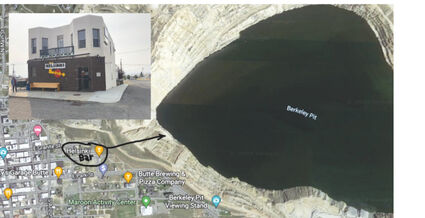Where the "Copper Kings" reigned
October 12, 2022
I recently wrote about my wife and I visiting the Merry Widow Health Mine in Basin, Montana. Before that stop we stayed three days in the Anaconda/Butte area and had the opportunity to learn about that part of the state where the Copper Kings reigned back in the day. I decided to write about my impressions of the area and its mining history. I came from a coal mining family and was curious to see how hard rock mining in Montana compared to underground and surface mining in the Midwest where I grew up. Here's some of what I observed and learned.
Copper mining in the Butte area started in the 1880's
Copper mining came after gold, silver and other minerals of interest. With the discovery of large deposits of copper around the Butte area, copper mining was launched and some operating mines began to focus on copper. The advent of electrical systems across the U.S. and around the world created a growing market for copper.
Marcus Daly, who came to the area working for a mining company, soon understood the potential of copper and by 1910, with help from other financiers, controlled most of the mining assets in and around Butte. Needing space and a steady water supply to smelt the ore, Daly built a smelter in Anaconda, twenty-five miles northwest of Butte, and his own railroad to haul the ore for processing in Anaconda.
The Butte/Anaconda area was a magnet for labor union organizers. At the turn of the 20th century there were 34 separate unions representing some 18,000 members in the area. Labor relations got particularly strained when Standard Oil investors entered the picture. They took a hard line and the labor unions pushed back.

In the 1950's the Anaconda company transitioned from underground mining to surface mining. That was when the Berkley Pit in Butte started. That pit was abandoned in 1982 ultimately leaving a mile by mile and half pit, an 1800 foot deep hole in Butte.
Two years earlier the smelting site in Anaconda was shut down leaving 16 million tons of slag in giant piles covering 195 acres. Slag is a black, sand-like byproduct of the smelting process. In 1983 the EPA (Environmental Protection Agency) designated the area a Superfund site and cleanup operations have been going for the past 40 years. There's still a long way to go.
Not unlike where I grew up in southern Illinois, mining took both a human and an environmental toll. Many areas in what is known as "little Egypt" in Illinois still show the scars of unregulated coal mining with piles of "gob" (a byproduct of cleaning the impurities from coal), tainted spoil piles and shafts and open pits filled with contaminated water. Black lung clinics still tend to miners who worked before modern health and safety standards were in place in the mines. And the costly cleanup of abandoned mine sites continues. Montana's abandoned mines do remind me of home, sadly.
Progress for the cleanup is painfully slow
Anaconda's smelting operation closed in 1982, now conspicuous by the remaining 585-foot smelter stack and about 300 square miles of polluted land and acres of black 'mountains' of slag. For forty years local economic development folks have been trying to find a use for the slag. Using on icy highways was first tried but traffic further crushed the slag making it more susceptible to leaching and polluting surrounding water sources. In the early 1980's RDM Enterprises used the slag in roofing and sandblasting products. In 2000 ARCO, the company legally bound to complete the cleanup, refused to renew RDM's access to the slag because of concerns the products using the slag might be deemed hazardous over time.
Most recently, with EPA approval, ARCO has begun 'capping' the piles of slag. From the highway we could see huge off-road end dumps bringing soil that dozers were then pushing uphill to create a layer of soil over the slag. Specially types of grasses are then planted to stabilize the slag piles. A few miles down the road slag heaps already covered and seeded have what appears to be a healthy and vigorous grass covering.
Over in Butte, the Berkley Pit remains a reclamation challenge. When the pit was closed in 1982 the dewatering pumps were shut down and the 'hole' began to fill from underground sources as well as catch surface runoff. Now there are about 40 billion gallons of water in the pit. The water is quite toxic, to the extent waterfowl that land in the pit water are "cooked from the inside out." Fortunately there is a means to keep the pit from overflowing. A controlled outlet allows water to be treated and safely discharged. It's clear the pit can never be reclaimed...it's too big, too deep and too contaminated. The hope is to keep it in check.
One last interesting stop in Butte
A cultural icon I wanted to see in Butte was the Helsinki Bar and Yacht Club. It's where the celebration of St. Urho Day first began in Montana. The make believe holiday honors a mythical saint who ran the grasshoppers out of Finland and saved the vineyards. Created back in the 1950's in Minnesota, the tradition was brought to Butte by Finnish miners lured by the top wages being paid in Butte. By the late 1930's the former boarding house in the center of Butte's Finn Town had public saunas, a beer hall and was the center of Finnish culture in the area. For readers not familiar with St. Urho's Day, it's celebrated on March 16, a chance for the Finns to get a leg up on celebrants of St. Patrick's Day on March 17.
The Berkley Pit, where surface mining for copper began in Butte, was opened in the early 1950's. Over the years the pit swallowed up many of Butte's ethnic areas, including Finn Town. Now the Helsinki Bar sits alone amid several acres of empty city blocks, an area that once part of a thriving Finnish community. The edge of the Berkley Pit, that closed in 1982, is about a third of a mile from the Helsinki Bar (see satellite photo). Finn Town is gone and the Helsinki Bar and Yacht Club is now open only on weekends. We never got to see inside the bar where St. Urho and his Lady are still crowned each year.


